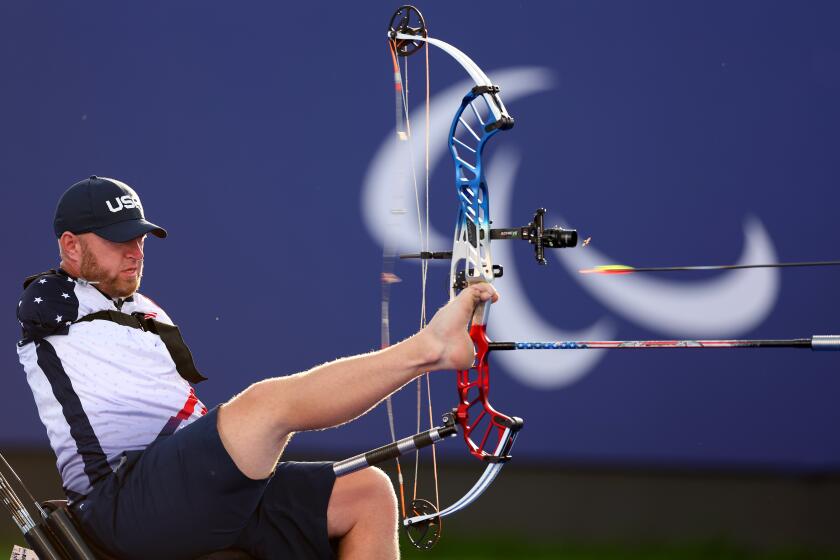Column: Design, then adjust: L.A. production designer rolls with challenges on, off stage
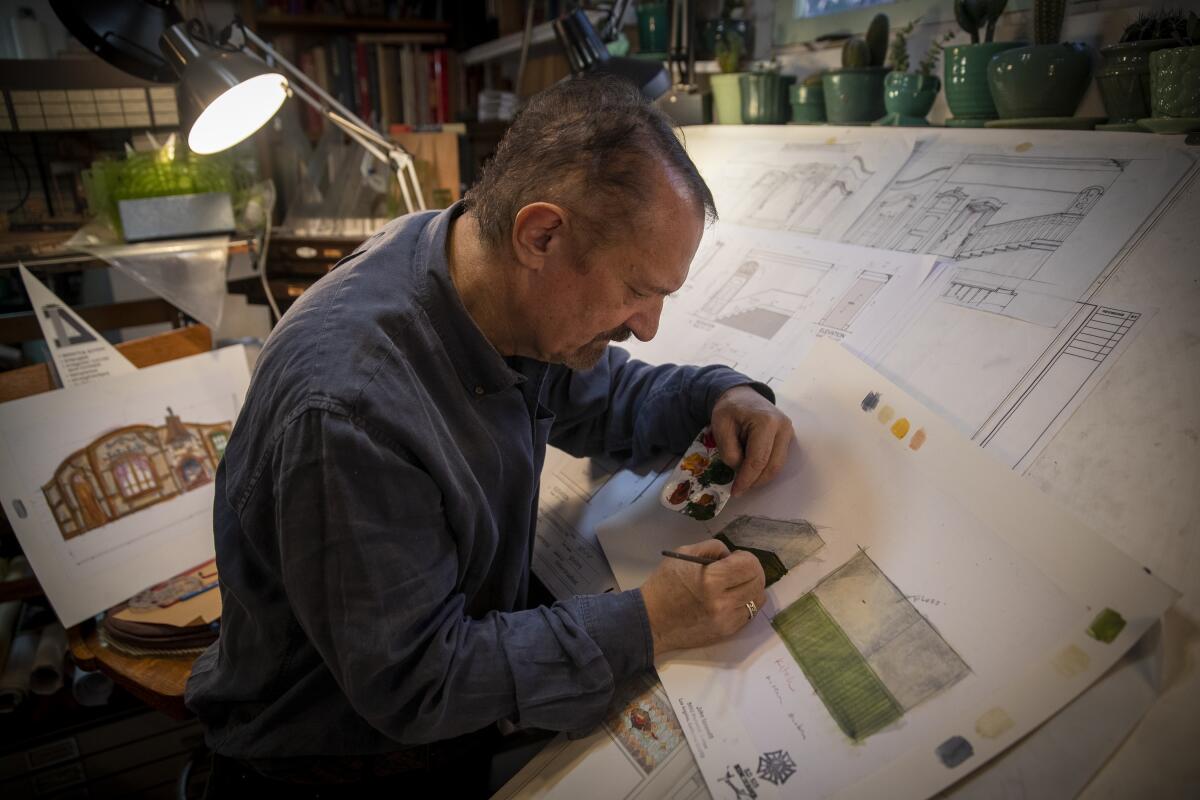
On the loading dock of the La Mirada Theatre for the Performing Arts, a group of men stands around a window seat. The seat has a lid, and when it’s lifted, the hinges creak long and loud. “We’ll just spray it with a little WD-40,” one of the men says. “That’ll take care of the creak.”
Standing next to him, John Iacovelli jumps as if stung.
“No,” he says emphatically, “that would be very bad. It’s all about the creak.”
“I wonder if I should put a note on it,” he adds, as he heads inside and onto the stage to oversee the placement of approximately 950 pictures and knickknacks on the set he has designed for the McCoy Rigby Entertainment production of “Arsenic and Old Lace.”
“No WD-40 allowed.”
The window seat in question is where two kindly old sisters store the body of a lonely old man they have done the favor of dispatching, and where their drama-critic nephew discovers it, setting off the screwball events of the play. The original body will be taken out and another put in; various characters sit, stand and lie down on it. Even with its glorious creak, the seat has caused Iacovelli a few headaches. There was early concern about its sturdiness, and later he discovered that the back had not been cut out to allow access to the “bodies” from backstage.
A few other problems have also presented themselves, but he isn’t concerned — it’s part of the game. Production designers design and then they adjust. This morning he spent an hour putting up pictures to hide the inevitable seam in one portion of the wallpaper, which is actually deep purple paint emblazoned with a silvery stencil that he created when he couldn’t find wallpaper he liked.
Design, then adjust; Iacovelli has been doing it for more than 40 years. “Peter Pan,” “Waiting for Godot,” “Joe Turner’s Come and Gone,” “Camelot,” “Sleepless in Seattle” — he has designed sets on Broadway, in Beijing and Athens, for national tours and hundreds of productions in virtually every L.A. theater you can name. While Iacovelli was finishing “Arsenic and Old Lace,” David Mamet called, asking him to design the set for his new play at the Odyssey.
Iacovelli also has worked on films including “Ruby in Paradise” and “Honey, I Shrunk the Kids,” and in television on “Babylon 5,” “Resurrection Blvd.” and “Ed.” He won an Emmy for a production of “Peter Pan” on A&E.
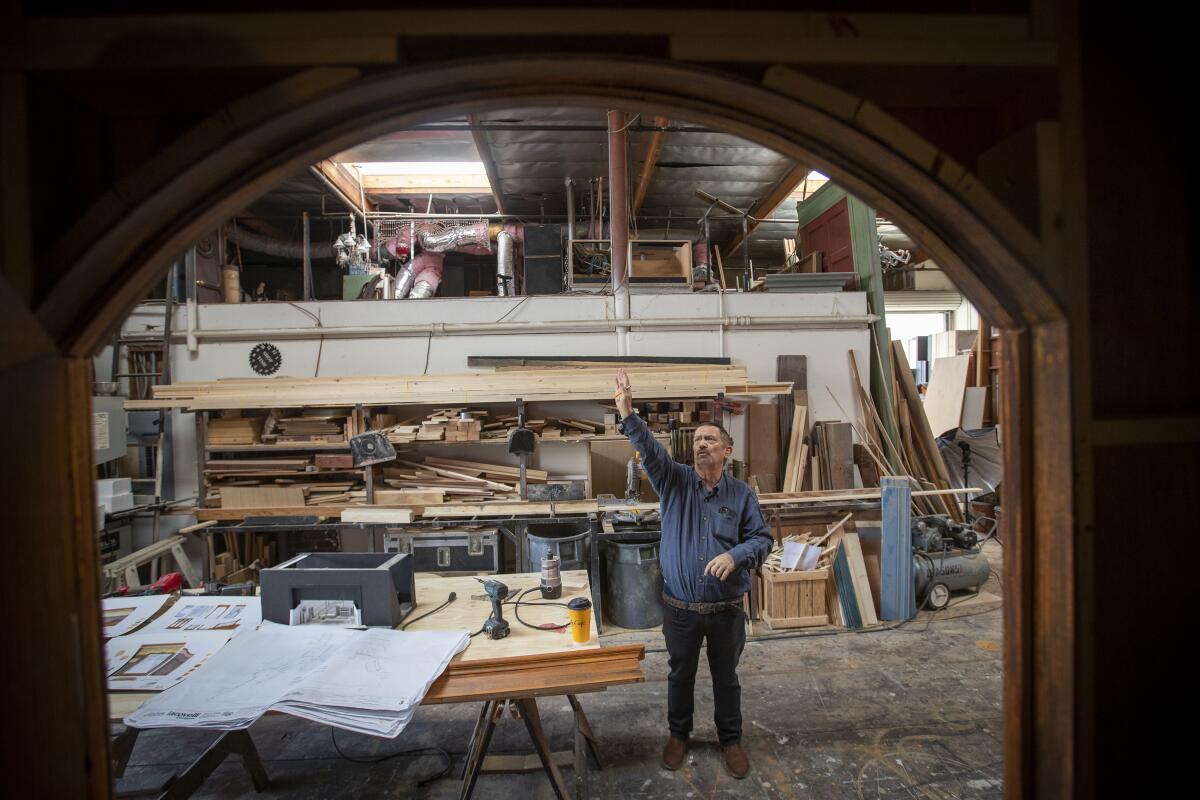
But it isn’t the lure of high-profile credits or awards that compels him to design his own wallpaper, spend hours in thrift stores looking for doorknobs, and obsess about archways and staircases. It’s the joy of helping to bring a play to life, of producing a set so artful that the audience will give no thought to all the work it required. The sketches, blueprints and models; the tonal choices of color; the careful calculations of wall height and furniture placement; the search for the right doors and sconces; the ability to work with tight deadlines and performers’ concerns.
“In the end, the set is there to serve the actors,” he says. “It is a machine for action.”
For Iacovelli, production design is about solving problems. Even when those problems are his own. Even when those problems include working through a cancer diagnosis and several rounds of chemotherapy because, well, the show must go on.
I met Iacovelli more than 20 years ago through my husband, with whom he has been friends since the 1980s. I did not see him often because he is very busy all the time — he also designs all the sets for shows on Princess Cruises and, until last year, taught production design at UC Davis. I have, however, seen many of his sets and always wondered how such things come into being. Last fall, I asked if I could follow him through the process. Having recently retired from Davis, Iacovelli agreed.
He also told me that he had just been diagnosed with a form of lymphoma, and not at an early stage. When I asked him if he’d rather not have me complicate his life even more, he sounded surprised. “Not at all,” he said. “It will be fun.”
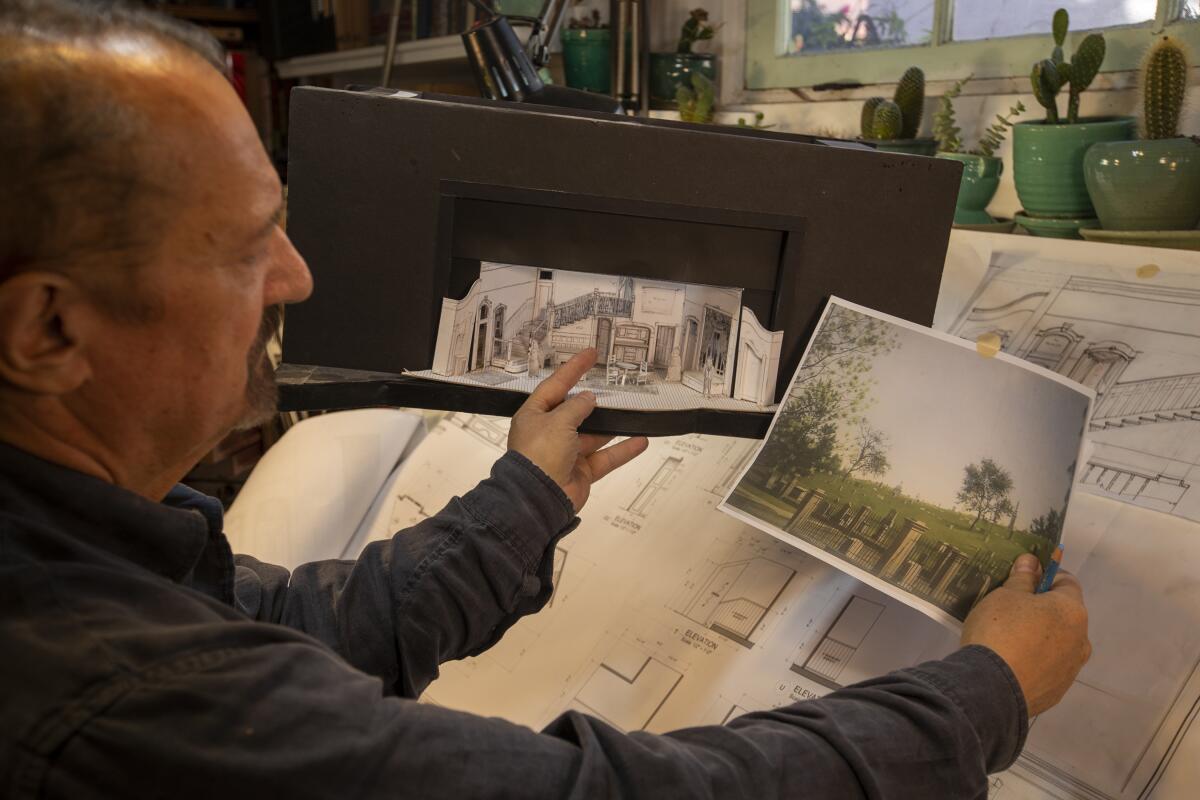
And it was fun, except when it wasn’t. For months I tagged along while Iacovelli did his work, badgering him with every sort of question: “What does ‘scumbling’ mean?” (Mixing a duller paint with a more vivid one, often on a floor.) “Did you really just tell that guy to use chewing gum to fill in a gap on the set?” (Yes, he did, but it was softened, not chewed.)
During those months, Iacovelli was often in the hospital. “This is not exactly what I had in mind when I retired from teaching,” he said at one point. “But it is what it is.”
Design, then adjust.
Iacovelli knew he would be working on “Arsenic and Old Lace,” directed by Casey Stangl, long before he knew he had cancer. Producer Tom McCoy, who along with wife Cathy Rigby, the actress and former Olympic gymnast, runs the theater series at La Mirada, brought him on board in February 2019.
Stangl, with whom Iacovelli had worked at South Coast Repertory a few years earlier, had asked for him. “John is very good at creating interiors that are beautiful, detailed and actor-friendly,” Stangl says. “He understands the production needs.”
Before he does anything, Iacovelli reads the play, first for pleasure and then for problems. Too many scene changes or a budget that conflicts with the basic needs can cause him to turn down a project. Theatrical production design is not a terribly lucrative profession — Iacovelli was paid $5,000 for his work on “Arsenic and Old Lace” — but for those who hear it, the siren call of theater is bewitching, a lover you cannot quit.
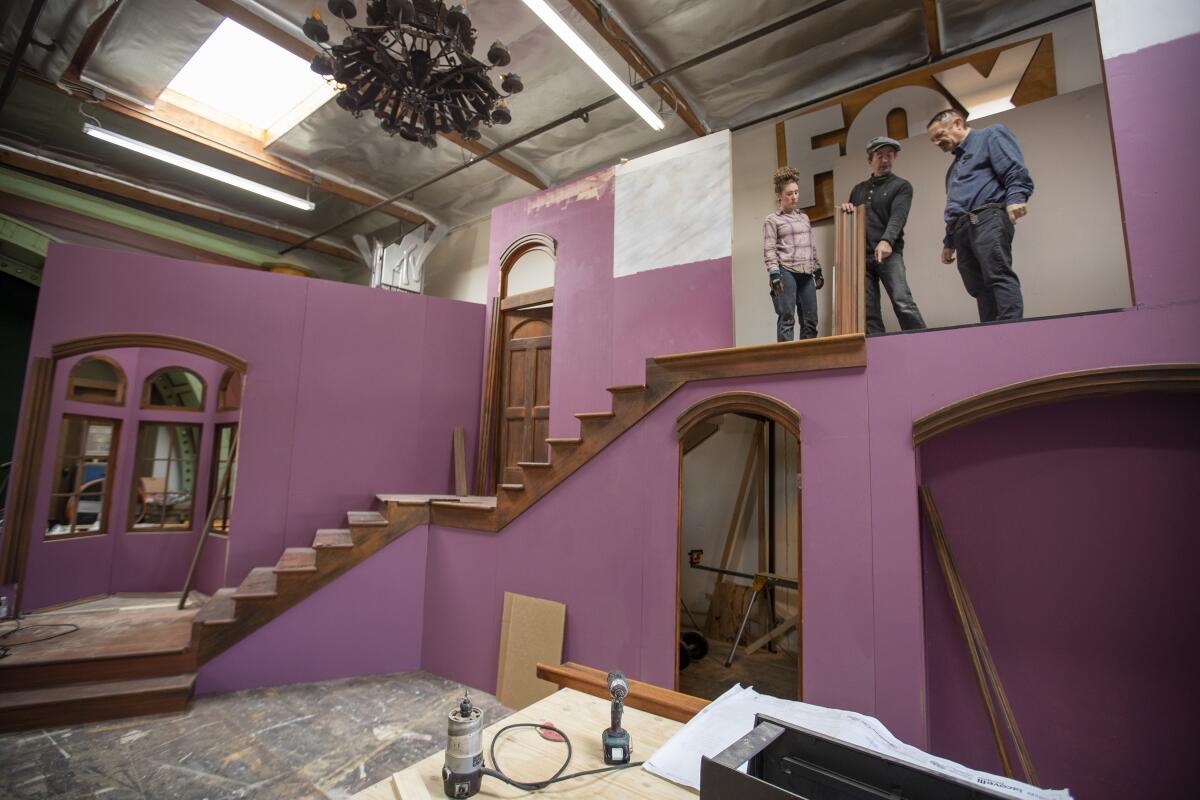
“I love it,” he says simply. “It is aggravating and exhausting and impossible and I love it.”
There is a lot of action in “Arsenic and Old Lace,” which makes certain pieces of the set nonnegotiable: the staircase leading up to the bedrooms, the prominent cellar door, the windows that open and are large enough to climb through and, of course, the seat beneath them, with its laughter-inducing creak.
“That creak was a miracle,” Stangl says. “We thought we’d have to use a sound effect.”
The biggest challenge was the doors. There are six of them and they all have to be fully functional.
“That’s a lot of doors, even for a comedy,” says Stangl. “And you want the set to extend a bit outside those doors. John is very good about those kind of details.”
“I wanted to use lace as a motif — the wallpaper, carpeting, fixtures. Even the staircase,” Iacovelli says, launching into a diatribe against designers who cut corners on staircases. “It can ruin a play for me,” he adds, laughing but completely serious. “I spend the whole time thinking, ‘How hard would it have been to make a staircase that looks like an actual staircase?’”
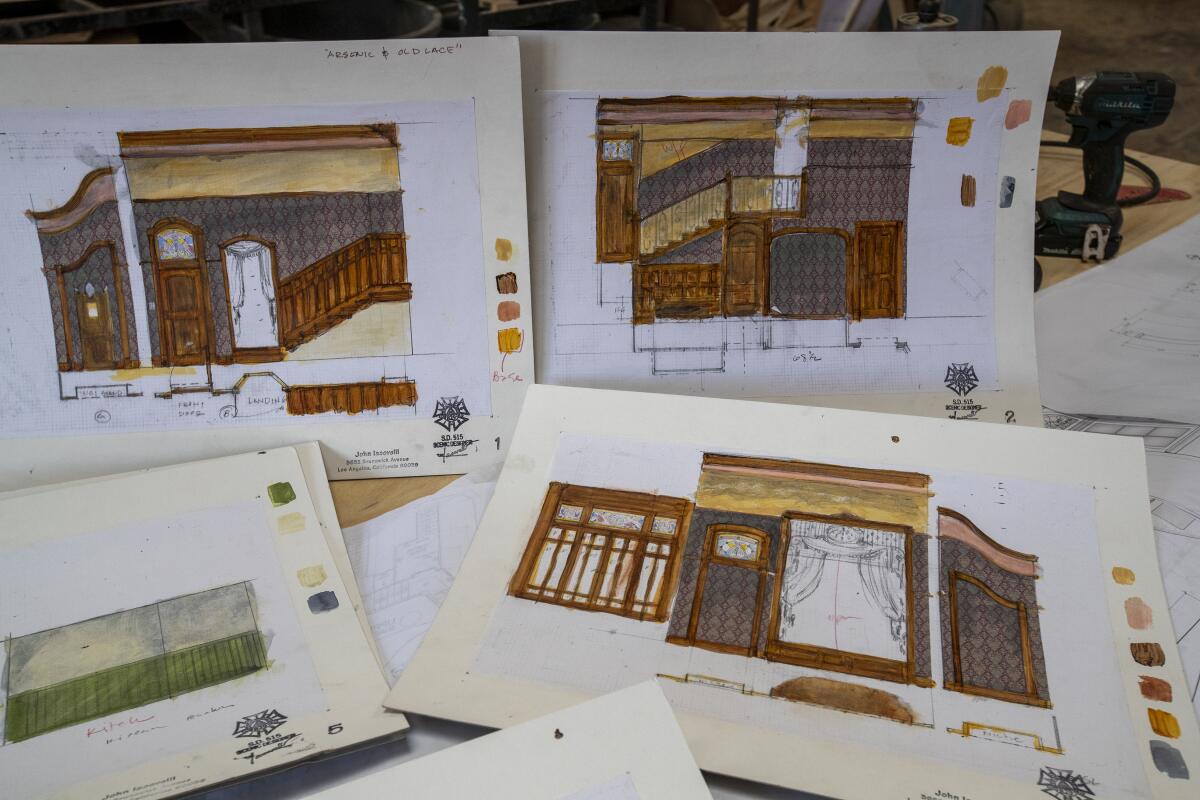
In July, Iacovelli began working on sketches of the house and the ground plan, which situates the basic elements of the set in relationship to the stage. Production design is an art form that involves an alarming amount of math, the algebra of scale and the geometry of sight lines. No portion of the set should block the view from any seat, nor should any audience member be able to glimpse the backstage area. Markings for furniture and doors and alcoves are added in different colors of ink until the ground plan resembles something like a blueprint that has been attacked by a group of children armed with a Spirograph and a fondness for drawing arrows.
All of which is interpreted by Iacovelli’s assistants, many of whom are his former students, who then create a white model, a replica of the set small enough to fit in a large shoebox.
When Stangl saw the model in early September, she was delighted with the back platform Iacovelli had added to give the action around the sideboard some elevation, but she preferred a built-in bench to a sofa. Iacovelli designed the bench and added an ottoman in place of the sofa.
“The ottoman was genius,” Stangl says. “It didn’t block anything and it allowed the actors to sit down in funnier ways.”
He tweaked the plans and then sent them out to three shops for bids. The original budget for the “Arsenic and Old Lace” set was $40,000; in the end, adding in props and set dressing, it cost around $54,000. The only portion of the original design they couldn’t afford was an architectural roof header that capped the set, designed to look like the exterior of a third floor.
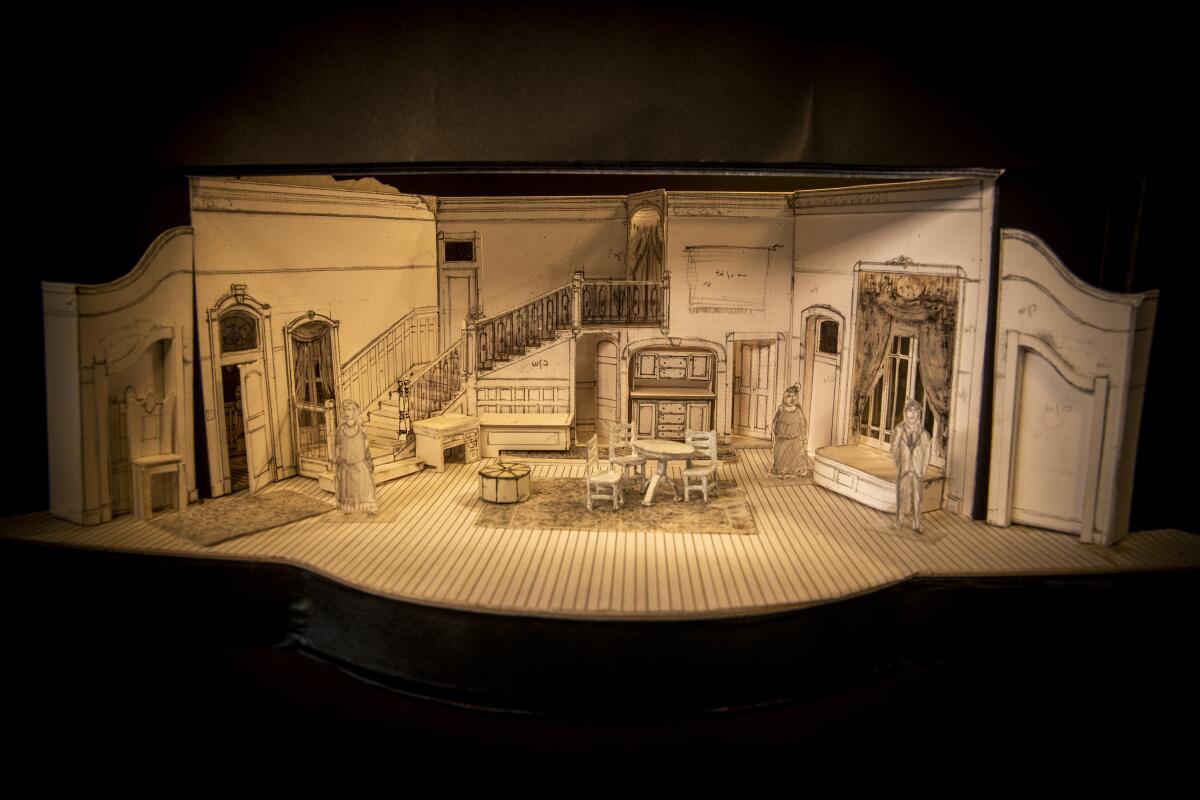
“We didn’t really need it,” Iacovelli says, adding with a sly smile, “I always design a feature that can be lost if the budget doesn’t cover it; sometimes it prevents fights over other things.”
In October, while he waited on the bids, Iacovelli finished up work on three other plays. He also started chemo, a process not known for its predictability or ease. The next month the bids came in and the Set Shop near Monrovia, run by Will Lidderdale, was chosen to build the set. Construction began in early December, leaving Iacovelli free to work with the prop master and find the right wallpaper, carpet and fixtures.
Linoleum City in East Hollywood, established in 1948, is a first stop for many production designers. Rolls of linoleum disguised as grass, wood flooring and bathroom tiles, dirty and clean, are stacked in one half of the warehouse, every kind of carpet imaginable in the other. Iacovelli knows what he wants — “I’m thinking something you would see in an old casino.” He immediately finds one sample he likes, but there’s too much blue in the pattern and he promised the costume designer he would stay away from blues.
He finds another, with green and gold, and sends a photo to Stangl, the prop master and the costume and lighting designers. He places an order with the caveat that it might change if anyone objects (no one does). Then he’s off to Burbank in search of the perfect wallpaper at Astek, another business that every production designer knows, but perfection eludes him. The samples with the right colors have patterns that are too small for a set, and larger patterns are too bright or too blue. “We’ll figure something out,” he says as he leaves.
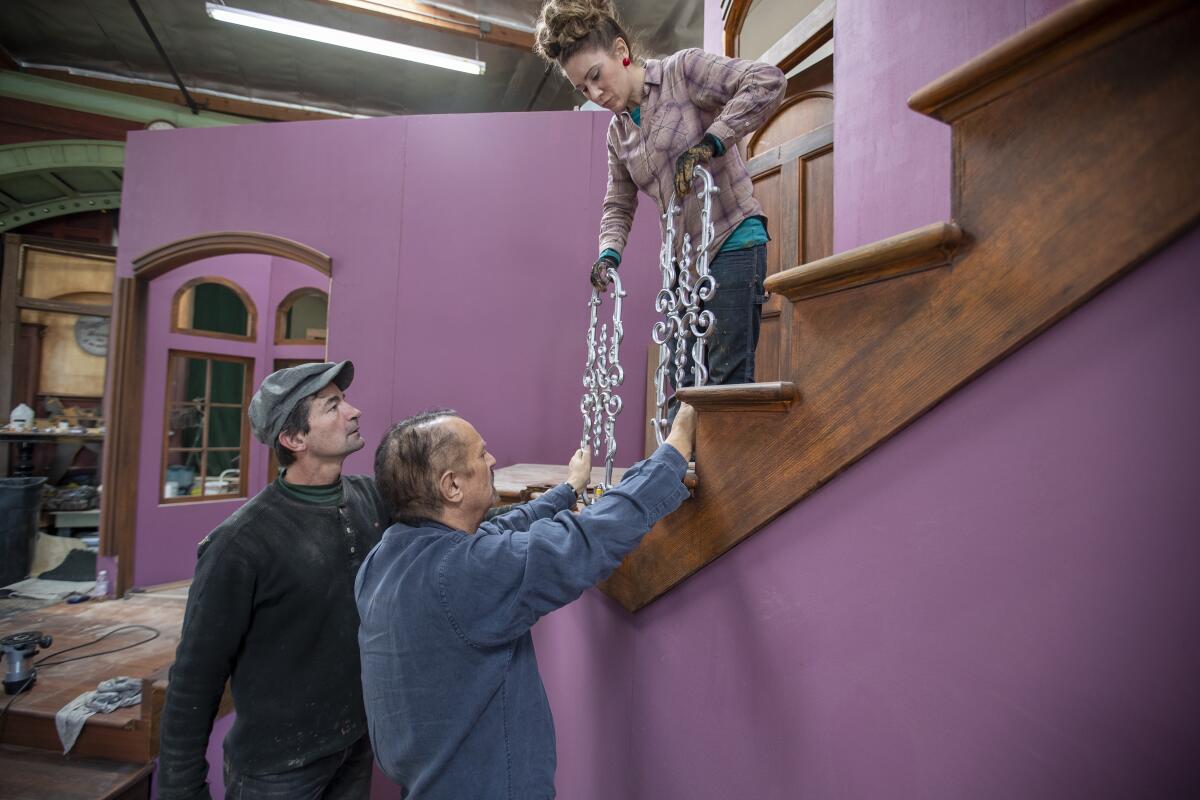
After the holidays, Iacovelli makes a few trips to the shop to see how things are progressing. He also makes a few trips to the hospital, including one that causes him to miss a designer presentation during which the cast is familiarized with the set and does a read-through. From the ER he arranges for someone else to bring down the model, some props and set dressing.
“One of my professors always said that your plans should be good enough that they could build the set even if you dropped dead before they started,” he says at one point. He laughs. I do not.
The very next week, Iacovelli is at the Set Shop to walk through the set with Jason Evans, technical director for McCoy Rigby, and adjust the “something” he had figured out regarding the wallpaper. Lidderdale’s work is in pieces but its miraculous splendor is apparent.
As he examines the windows and the doors and goes up and down the staircase, Iacovelli offers Lidderdale and his staff many compliments and a few directives. The big window that goes over the window seat needs Plexiglas; the flooring that goes under the sideboard does not need to be painted. Most important, the “wallpaper,” which Lidderdale stenciled by hand, is too bright. Iacovelli wants it covered with a tobacco-colored glaze. “Use a brush first,” he says, squatting before a bit of wall that will be covered by the sideboard to test the process, “then blot it off with a towel. Like little cat paws.”
“One of my professors always said that your plans should be good enough that they could build the set even if you dropped dead before they started.”
— John Iacovelli
The set is loaded into the La Mirada Theatre a few days later, less than a week before opening night in January. It takes two days but by the second, the stage has been completely transformed. The glazed walls are perfect (aged but not gloomy); the staircase is solid yet graceful; the sofa bench is comfortable with myriad old-fashioned cushions; and the walls are covered with all sorts of pictures that are just fussy enough. The big windows open easily, as do all the doors, offering glimpses of the kitchen, the cellar, the front porch.
In many ways, the set is the most complicated and important character in the play; Iacovelli designed it to extend on either side all the way to the edge of the stage, to draw the audience in. While introducing the play on opening night, McCoy points to it with pride and asks Iacovelli to stand, which he does to much applause.
As with an actual house, things need to settle a bit. In the first act, a picture falls from one of the back walls and is whisked off the stage by the actor headed in the right direction. In the second, the front door bounces open once when it is slammed shut. “I think it looks better without that picture,” Iacovelli says when the show has ended. As for the door, he shrugs and says, “We’ll figure it out.”
Not that the audience minded, or even noticed. The attendees are all too busy laughing at the machinations around the window seat, which creaks with marvelous satisfaction, every time it is opened.
And Iacovelli has some news: On the first day of the load-in, he heard from his doctor and he is in complete remission.
More to Read
The biggest entertainment stories
Get our big stories about Hollywood, film, television, music, arts, culture and more right in your inbox as soon as they publish.
You may occasionally receive promotional content from the Los Angeles Times.













